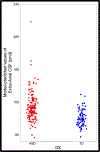Extra-axial cerebrospinal fluid in high-risk and normal-risk children with autism aged 2-4 years: a case-control study
- PMID: 30270033
- PMCID: PMC6223655
- DOI: 10.1016/S2215-0366(18)30294-3
Extra-axial cerebrospinal fluid in high-risk and normal-risk children with autism aged 2-4 years: a case-control study
Abstract
Background: We previously showed, in two separate cohorts, that high-risk infants who were later diagnosed with autism spectrum disorder had abnormally high extra-axial cerebrospinal fluid (CSF) volume from age 6-24 months. The presence of increased extra-axial CSF volume preceded the onset of behavioural symptoms of autism and was predictive of a later diagnosis of autism spectrum disorder. In this study, we aimed to establish whether increased extra-axial CSF volume is found in a large, independent sample of children diagnosed with autism spectrum disorder, whether extra-axial CSF remains abnormally increased beyond infancy, and whether it is present in both normal-risk and high-risk children with autism.
Methods: In this case-control MRI study, children with autism spectrum disorder or with typical development aged 2-4 years were recruited from the community to the UC Davis MIND Institute Autism Phenome Project, based in Sacramento, CA, USA. The autism spectrum disorder group comprised children with autism spectrum disorder who were either normal risk (ie, from simplex families) or high risk (ie, from multiplex families). Measurements of extra-axial CSF volume, brain volume, head circumference, sleep problems, and familial risk status were derived from MRI and behavioural assessments. We applied a previously validated machine learning algorithm based on extra-axial CSF volume, brain volume, age, and sex to the current dataset.
Findings: Between July 20, 2007, and Dec 13, 2012, 159 children with autism spectrum disorder (132 male, 27 female) and 77 with typical development (49 male, 28 female) underwent MRI scans. The autism spectrum disorder group had an average of 15·1% more extra-axial CSF than controls after accounting for differences in brain volume, weight, age, and sex (least-squares mean 116·74 cm3 [SE 3·33] in autism group vs 101·40 cm3 [3·93] in typical development group; p=0·007; Cohen's d = 0·39). Subgroups of normal-risk (n=132) and high-risk (n=27) children with autism spectrum disorder had nearly identical extra-axial CSF volumes (p=0·78), and both subgroups had significantly greater volumes than controls. Both extra-axial CSF volume (p=0·004) and brain volume (p<0·0001) uniquely contributed to enlarged head circumference in the autism spectrum disorder group (p=0·04). Increased extra-axial CSF volume was associated with greater sleep disturbances (p=0·03) and lower non-verbal ability (p=0·04). The machine learning algorithm correctly predicted autism spectrum disorder diagnosis with a positive predictive value of 83% (95% CI 76·2-88·3).
Interpretation: Increased extra-axial CSF volume is a reliable brain anomaly that has now been found in three independent cohorts, comprising both high-risk and normal-risk children with autism spectrum disorder. Increased extra-axial CSF volume is detectable using conventional structural MRI scans from infancy through to age 3 years. These results suggest that increased extra-axial CSF volume could be an early stratification biomarker of a biologically based subtype of autism that might share a common underlying pathophysiology.
Funding: US National Institutes of Health.
Copyright © 2018 Elsevier Ltd. All rights reserved.
Figures





Comment in
-
Anatomical brain abnormalities and early detection of autism.Lancet Psychiatry. 2018 Nov;5(11):857-859. doi: 10.1016/S2215-0366(18)30355-9. Epub 2018 Sep 27. Lancet Psychiatry. 2018. PMID: 30270034 No abstract available.
References
-
- Barlow CF. CSF dynamics in hydrocephalus—With special attention to external hydrocephalus. Brain and Development 1984; 6: 119–27. - PubMed
-
- Maytal J, Alvarez LA, Elkin CM, Shinnar S. External hydrocephalus: radiologic spectrum and differentiation from cerebral atrophy. American Journal of Roentgenology 1987; 148: 1223–30. - PubMed
-
- Odita JC. The widened frontal subarachnoid space. A CT comparative study between macrocephalic, microcephalic, and normocephalic infants and children. Childs Nerv Syst 1992; 8: 36–9. - PubMed

